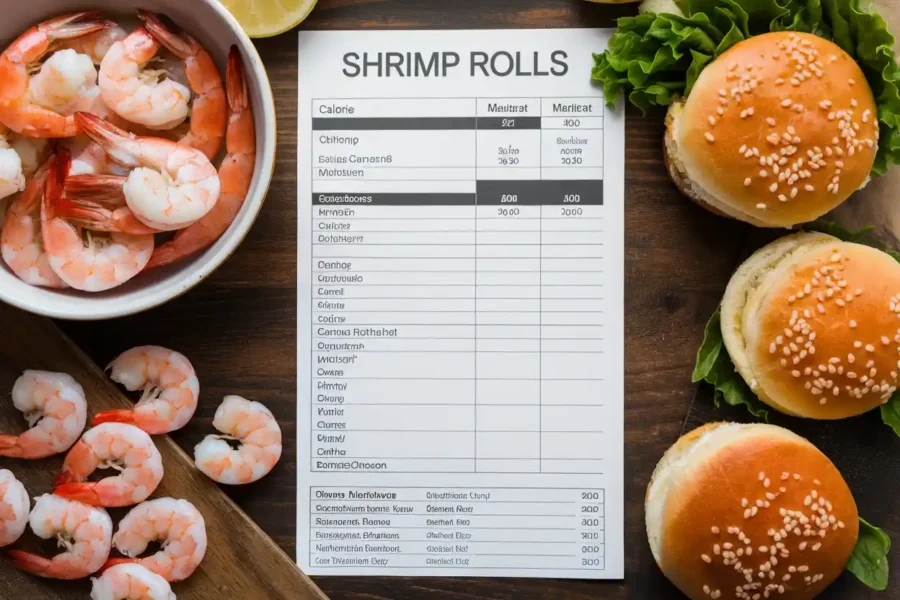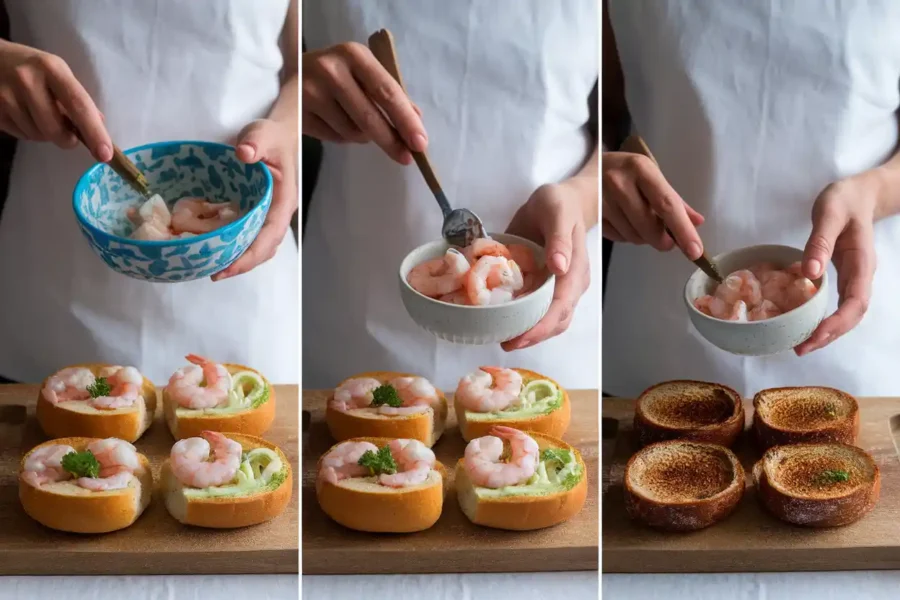Shrimp rolls are a beloved seafood treat that combines succulent shrimp, soft bread, and flavorful dressings. Whether you’ve indulged in one at a summer cookout or ordered it at a seaside restaurant, shrimp rolls have a universal appeal. But for those mindful of their calorie intake, an important question arises: Are shrimp rolls high in calories? This article dives into the nutritional breakdown of shrimp rolls, factors affecting their calorie content, health benefits, and even tips to make them healthier. By the end, you’ll have a clear understanding of how shrimp rolls fit into your diet and whether they’re a healthy choice.
Table of Contents
Introduction to Shrimp Rolls
What Are Shrimp Rolls?
Shrimp rolls are a seafood delight that usually consists of freshly cooked shrimp tossed in a creamy dressing and served in a buttery, toasted bun. The shrimp are often seasoned with a blend of spices, herbs, and sometimes a touch of lemon for brightness. This dish is particularly popular in coastal areas and has gained a reputation for being both simple to prepare and packed with flavor.
Popularity of Shrimp Rolls in Different Cuisines
While shrimp rolls are often associated with New England-style cuisine, they’ve become a global favorite, appearing in various forms around the world. In Asian cuisines, for instance, shrimp rolls might take the shape of rice paper wraps, combining shrimp with vegetables and dipping sauces. Meanwhile, Western versions focus on indulgent fillings with creamy dressings and buttery rolls. This versatility contributes to their widespread appeal, making shrimp rolls a go-to choice for seafood lovers everywhere.
Nutritional Breakdown of Shrimp Rolls
Calories in Shrimp Rolls: A Closer Look
When asking “Are shrimp rolls high in calories?”, the answer depends on the ingredients and preparation. On average, a single shrimp roll contains 250–400 calories, but the number can climb higher depending on the recipe. The calorie content primarily comes from the roll’s buttery bun and creamy sauces, which add richness but can increase the calorie count significantly.
Macronutrients: Protein, Fats, and Carbs
Shrimp rolls provide a healthy dose of protein from shrimp, averaging around 15–20 grams per serving. The bun contributes carbohydrates, while mayonnaise and butter supply fats. While shrimp itself is low in calories, the added ingredients significantly influence the macronutrient profile. For instance, fried shrimp adds more fat than boiled or grilled options.
Key Ingredients That Impact Calorie Count
The type of bun, cooking method for shrimp, and choice of dressing all affect calorie content. A brioche bun, for instance, is denser and higher in calories compared to a standard hot dog bun. Meanwhile, using low-fat mayonnaise or Greek yogurt as a dressing base can significantly reduce the calorie count without compromising flavor.

Factors That Influence the Calorie Content
Type of Shrimp Used: Fresh, Fried, or Boiled
The preparation method for shrimp plays a big role in determining the calorie count. Boiled or grilled shrimp keeps the dish lighter, while fried shrimp adds a crispy texture but also more fat and calories. A serving of fried shrimp can add an extra 50–100 calories to the roll.
Additional Ingredients: Mayonnaise, Butter, and Sauces
The creamy dressing and buttery bun are often the culprits behind higher calorie counts in shrimp rolls. Substituting regular mayonnaise with a low-fat alternative or using a light spread of butter can trim down the calories without sacrificing taste.
Size and Portion Variations of Shrimp Rolls
The portion size also matters. A larger roll, with more shrimp and dressing, naturally contains more calories than a smaller serving. For a balanced meal, consider pairing a shrimp roll with a side salad or steamed veggies instead of chips or fries.
Are Shrimp Rolls a Healthy Option?
Health Benefits of Shrimp Rolls
Shrimp rolls can be a nutritious choice, depending on how they’re prepared. Shrimp itself is a low-calorie, protein-packed seafood that’s also rich in omega-3 fatty acids, which support heart health. Additionally, shrimp provides essential nutrients like selenium, vitamin B12, and iodine, which promote overall well-being.
When made with fresh, simple ingredients, shrimp rolls can be a balanced meal. Swapping out calorie-heavy sauces for lighter dressings or using whole-grain buns can further enhance their health profile without compromising flavor.
Potential Downsides: Sodium, Fats, and Additives
Despite their benefits, shrimp rolls aren’t without potential drawbacks. Some recipes rely heavily on butter, mayonnaise, or fried shrimp, which can increase the fat content. Additionally, the sodium in shrimp and processed ingredients can contribute to higher sodium levels in the dish, which is worth considering for individuals watching their salt intake.
When asking “Are shrimp rolls high in calories?”, the answer depends largely on these factors. Opting for homemade versions allows greater control over ingredients, making it easier to avoid hidden calories and unhealthy additives.
Tips for Making Shrimp Rolls Healthier

Using Low-Calorie Ingredients
To create a healthier shrimp roll, consider replacing traditional mayonnaise with Greek yogurt or an avocado-based spread. These alternatives reduce calorie content while adding a creamy texture and extra nutrients. Using low-sodium seasoning blends can also help keep the dish flavorful without excess salt.
Baking Instead of Frying: A Lighter Alternative
Instead of frying shrimp, bake or grill them for a lighter option that retains their natural flavor. Adding a sprinkle of smoked paprika or lemon zest before cooking enhances the taste without additional calories.
Portion Control: Enjoy in Moderation
Portion size plays a crucial role in making shrimp rolls part of a balanced diet. Opt for smaller buns or consider serving the filling over a salad for a low-carb alternative. Pair your shrimp roll with a side of roasted veggies or a light soup to keep the meal satisfying but not overly indulgent.
For more delicious recipes that focus on balanced eating, explore this Shrimp Roll Recipe Guide.
Comparing Shrimp Rolls to Other Seafood Dishes
Shrimp Rolls vs. Sushi Rolls
When considering “Are shrimp rolls high in calories?”, comparing them to sushi rolls provides helpful insight. Sushi rolls often contain rice, raw fish, and seaweed, making them lighter in calories typically around 200–300 calories per roll. Shrimp rolls, on the other hand, use a buttery bun and creamy sauces, which can double the calorie count. However, shrimp rolls often provide a richer flavor and heartier texture, making them more filling.
Shrimp Rolls vs. Lobster Rolls
Lobster rolls are another popular seafood dish that shares similarities with shrimp rolls. However, lobster rolls are generally higher in calories due to the larger portion size and often richer dressings. While shrimp is naturally leaner than lobster, both rolls are indulgent treats, and their calorie count depends on preparation methods and ingredient choices.
How Shrimp Rolls Rank Among Popular Seafood Options
Among seafood dishes, shrimp rolls strike a balance between indulgence and nutrition. Compared to fried fish sandwiches or clam chowder, shrimp rolls often have fewer calories and less fat, especially when prepared with lighter ingredients. That said, moderation and portion control are key to keeping this dish diet-friendly.
Frequently Asked Questions
How to Wrap a Shrimp Roll?
Wrapping a shrimp roll involves a few simple steps. First, prepare your shrimp filling by combining cooked shrimp with your choice of dressing. Then, toast a buttery bun until golden. Place the shrimp mixture inside the bun, ensuring an even distribution for every bite. For an added touch, garnish with fresh herbs or a squeeze of lemon.
Does a Crunchy Roll Have Shrimp?
Yes, crunchy rolls can include shrimp, but they’re not the same as shrimp rolls. Crunchy rolls are a type of sushi roll, often made with tempura shrimp, avocado, and a crispy topping like fried tempura flakes. While shrimp rolls use buns and creamy dressings, crunchy rolls are a lighter, sushi-inspired alternative.
What Is a Shrimp Roll Made Of?
A classic shrimp roll is made with cooked shrimp, mayonnaise or dressing, and seasonings, all served in a toasted bun. Variations can include additional ingredients like celery, herbs, or lemon juice for extra flavor.
Are Shrimp Rolls High in Calories Compared to Homemade Versions?
Store-bought or restaurant shrimp rolls are often higher in calories due to the generous use of butter, mayonnaise, and large portions. Homemade shrimp rolls offer the opportunity to control ingredients, making them lighter and more customizable to dietary preferences.
Conclusion: Shrimp Rolls and Your Diet
Finding Balance: When to Indulge in Shrimp Rolls
When asking “Are shrimp rolls high in calories?”, the answer depends on how and when you enjoy them. Shrimp rolls can fit into a balanced diet, especially if you’re mindful of portion sizes and ingredient choices. They’re perfect as an occasional indulgence or a hearty treat for seafood lovers. Pairing them with lighter sides like salads or steamed vegetables can help keep the meal balanced without sacrificing flavor.
Final Thoughts on Shrimp Rolls and Calorie Counts
While shrimp rolls can be higher in calories than some other seafood dishes, they’re also rich in protein and bursting with flavor. By preparing them at home with low-calorie ingredients, you can enjoy all their deliciousness without worrying about overindulging. Ultimately, shrimp rolls can be as healthy or as indulgent as you choose to make them. Moderation and thoughtful preparation are the keys to making them a part of a wholesome diet.

